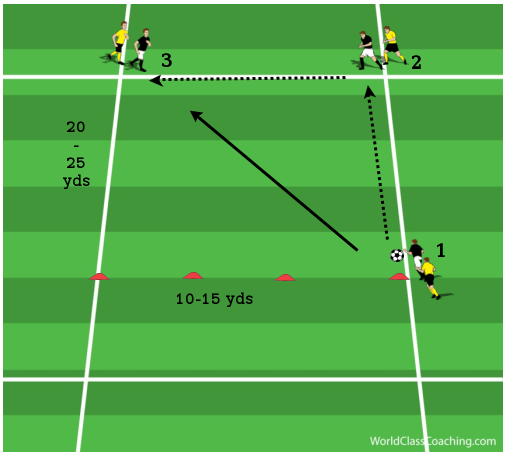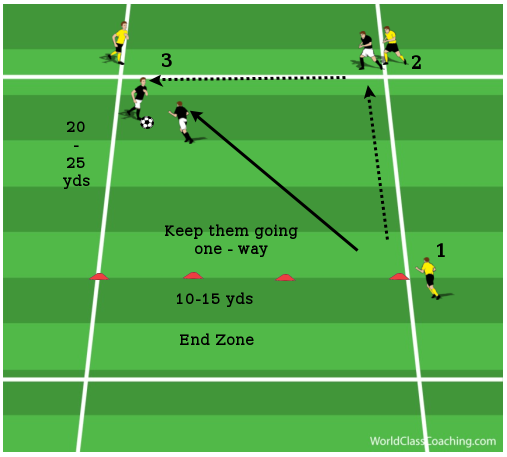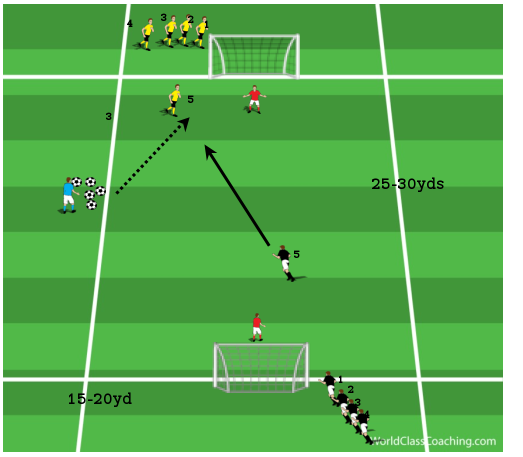By Sean Reed -
Objective
This is a defending session that focuses on defending 1v1, getting up to the ball.
Passive Defending – Getting up to the Ball

Diagram 1
Set Up
- The minimum number for this session is 3, beyond that you can split the groups or put more players into one group. As the coach it is important that you manage the rest and rotation. For the purposes of this we will explain it using the diagram 1
- The area is outlined as above, can be 20-25yds long x 10-15yds wide. The coach might find that when it becomes competitive it will be necessary to extend the length
- Working in 3’s Player (1) starts with the ball, plays a pass into Player (2) who must take a touch before playing a pass across to Player (3). As player (2) plays his pass, Player (1) can start their movement to close Player (2) down. Please note, monitor the distance that Player (1) is starting from as they might need to be moved closer, but the coach can make that decision
- Player (2) on receiving the ball is looking to travel with the ball across the cones outlined, adjusting their position trying to come inside and force the defending Player (1) to move.
- For this session the defending Player (1) is passive
- The next group then goes. Then Player (1) goes where Player (2) was and Player (2) goes where player (3) was.
- After a number of turns start down the other side
Progressions
- To make it competitive. The objective of the defending Player (1) is to win the ball, force a mistake and / or prevent the Attacking Player (2) to travel with the ball under control across the End Zone line. See diagram 2
- Change the order so they compete against other players
Coaching Points
- Acceleration up the player receiving the ball
- Approach to the ball, showing them the attacker into area you want them to play in
- Deceleration on approach
- Reduce the space available for the attacking to play in and try to get their head down
- Body shape side on, for adjustment to the side or in behind
- Weight on the back foot
- Be prepared for the ball to be pushed into space behind the defender
- On the balls on the feet prepared for next movement
- Avoid crouching over too far otherwise will affect ability to turn / change direction effectively
- Can the defender keep the attacking player going one way, preventing them of coming back inside to open up the size of the pitch
Session 2 – Competitive Defending

Diagram 2
[wpsharely id="1204"][/wpsharely]
Session 3 – 1v1 Attacking and Defending Small Goals

Diagram 3
Set Up
- The pitch dimensions 25-30yds in length and 15yds wide
- Split teams into two and each team with number there players 1-5 in the case of diagram 3
- The teams are in a small area 5x5yd, which they must stay in until their number is called
- The balls start with the coach on the side
- Ideally if the coach has small samba goals available for this pitch size, with a goalkeeper in each goal
- One team will start the attacking and one team with start as defenders.
- The coach will call a number between 1-5 in the case of diagram 3 and the number from each team will run out. Whichever team is attacking, the coach will play to that player. Once that ball is out of play or the keeper has the ball in their hands. The coach will play another ball in, into the attacking team.
- If the defender can win possession then they can then try and score
- This can either continue for a set number of balls (i.e. 3 Ball) or a period of time (20 secs).
- The coach can decide how many times each player with go through before changing the team’s roles (defending and attacking). Please note that the coach will need to change the Goalkeepers so they do not remain with the defending team or attacking team every round.
- Although the focus is primarily on the defending, players will still be working on the attacking and transition both ways
- Keep score to make it competitive
Coaching Points
- Get up to the ball as quickly as possible
- When possible look to force the attacking player away from goal and on their weaker foot
- As above, continue to get up to the player, closing their space, preventing them from turning when playing with their back to goal
- Encourage the defender to stay on their feet, avoid committing themselves and going to ground easily
- Communication from Goalkeepers and other players
By Sean Reed
Former First Team Coach of Championship side Fulham FC. Sean is a UEFA A Coach with a Masters in Sport Coaching. He has over 15 years of experience working in professional football from Academy through to First team in the Premiership and Championship.
Linkedin - www.developmentofplayers.com
Twitter - @SeanJReed


